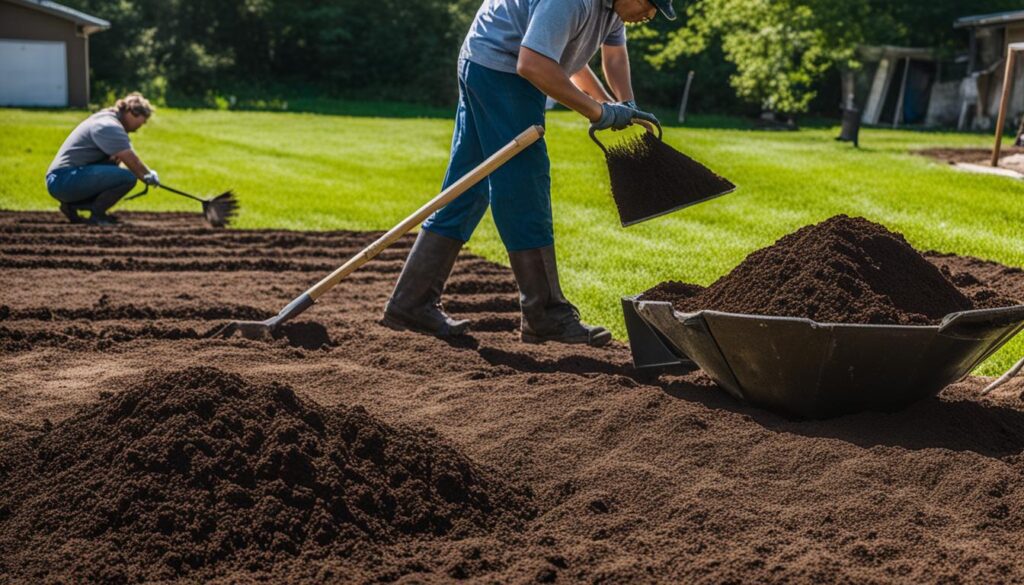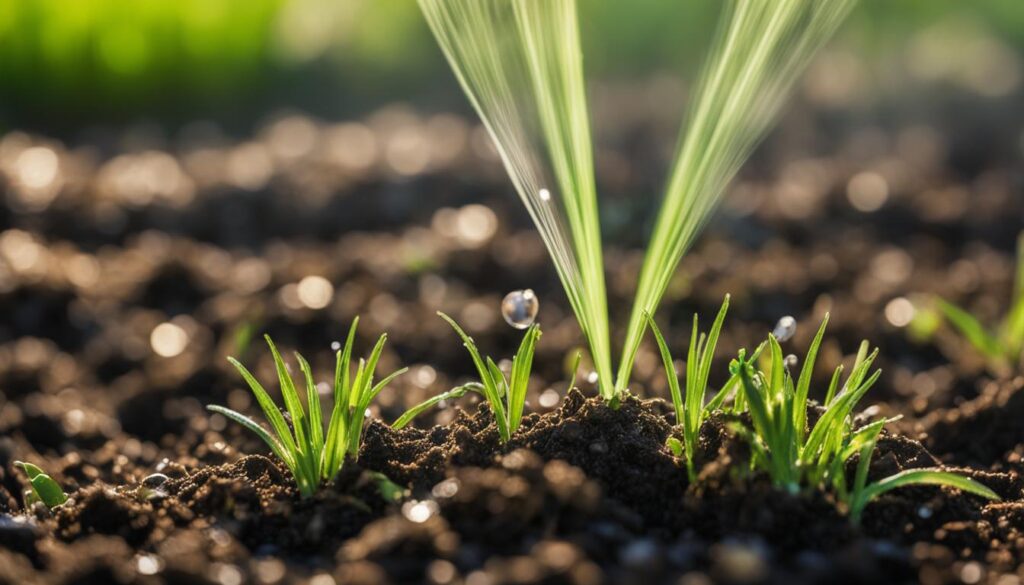If you’re looking to establish a lush, green lawn quickly, you’ve come to the right place. In this article, we will provide you with essential tips on how to grow grass fast on dirt and speed up lawn growth. By following these techniques, you’ll be able to achieve a beautiful, vibrant lawn in no time.
The secret to growing grass quickly on dirt starts with choosing the right seed. By selecting the appropriate seed for your region, you can ensure optimal growth. We’ll discuss the different types of grass seed and their suitability for various climates.
Additionally, we’ll delve into the importance of proper soil preparation for your lawn. Prepping the soil correctly is vital for the grass to take root and flourish. We’ll guide you through the steps to remove any existing grass and weeds, as well as how to level the soil effectively.
Seeding and feeding play a crucial role in expediting grass growth. We’ll provide you with expert advice on how to seed the soil properly and recommend high-quality starter fertilizer that can boost grass growth by up to 70%.
Watering and protecting your newly seeded lawn is essential for its survival. We’ll explain the best watering techniques to ensure your grass receives adequate moisture without drowning it. Additionally, we’ll share tips on how to protect your lawn from foot traffic and pet activity during its early stages.
Finally, we’ll discuss the proper mowing techniques for newly seeded lawns and how to prevent weed growth. By following these guidelines, you’ll be able to maintain a healthy lawn and prevent any setbacks in your grass growth journey.
In conclusion, by implementing these tips and tricks, you can grow grass quickly on dirt and achieve a lush, green lawn in a shorter amount of time. The road to a beautiful lawn begins with the proper seed selection and extends to soil preparation, seeding and feeding, watering and protection, and mowing techniques. With patience and diligence, you’ll soon enjoy the fruits of your labor as your grass thrives and transforms your outdoor space into a vibrant oasis.
Choosing the Right Seed
When it comes to growing a beautiful lawn, choosing the right grass seed is key. The type of grass seed you select should be based on your specific climate and region.
Cool season grasses, such as those found in the Northwest, Midwest, and Northeast, thrive in areas with large temperature swings throughout the year. These grasses have the ability to withstand cold winters and hot summers.
On the other hand, warm season grasses are better suited for regions with consistent warm weather, like the Southwest, Deep South, and Mid-South. These grasses thrive in the heat and can handle the occasional drought.
By selecting the appropriate grass seed for your area, you can ensure optimal growth and a healthier lawn. For high-performance grass seed that jumpstarts growth and leads to a thicker, greener lawn in less time, consider products like Scotts® Turf Builder®.
Prepping the Soil
Before you can grow grass on dirt, it’s important to prepare the soil properly. By taking a few necessary steps, you can create an ideal environment for your grass to thrive.
First, start by removing any existing grass, weeds, and large rocks from the area where you plan to grow your lawn. This will help minimize competition and create space for the new grass to establish itself.
Next, fill in any low spots with high-quality soil, such as Scotts® Turf Builder® LawnSoil™. This will help create a level surface and ensure that your grass grows evenly.
If the soil in your area is compacted, consider using a tiller to loosen it up. This will improve drainage and allow the grass roots to penetrate the soil more easily.
Once the soil is prepared and level, use a hard rake to even out the surface. This will provide a smooth foundation for your grass to take root and grow.
Remember, proper soil preparation is essential for the successful growth of your grass. Taking the time to remove existing vegetation, fill in low spots, and create a level surface will set the stage for a healthy and vibrant lawn.
Seeding and Feeding
To promote fast grass growth, it’s crucial to seed and feed your lawn properly. After preparing the soil, spread a thin layer of high-quality grass seed using a spreader, ensuring even distribution. Following seeding, apply a starter fertilizer, like Scotts® Turf Builder® Starter® Food for New Grass, which can help grass grow up to 70% thicker and 35% faster. It’s important to follow the package directions carefully for recommended seeding rates and techniques to achieve optimal results.
Watering and Protecting the Grass
Adequate watering is essential for watering new grass seed to germinate and establish roots. To ensure successful growth, you need to maintain proper soil moisture levels. Follow these steps to keep your newly seeded lawn healthy:
1. Mist Daily Until Germination
After seeding, mist the area daily to keep the top inch of soil moist. This gentle watering technique helps the seeds sprout and initiates the germination process. Remember to water early in the morning or late in the evening to reduce evaporation.
2. Switch to Light Watering
Once the grass begins to sprout, switch to light watering every few days. The goal is to maintain moisture in the top 2 inches of soil. Be careful not to overwater, as this can lead to shallow root growth and weak grass.
3. Water Deeply as Grass Grows
As the grass grows taller, it’s important to water deeply to ensure moisture reaches the deeper soil layers. This encourages stronger root development and helps the grass withstand dry periods. Watering deeply once or twice a week is usually sufficient, depending on the weather conditions in your area.
4. Protect from Foot Traffic and Pets
To allow your newly seeded lawn to develop properly, it’s vital to protect it from excessive foot traffic and pet activity for at least a month. This gives the grass time to establish its roots and grow stronger. Consider setting up temporary barriers or redirecting foot traffic away from the seeded areas.
By following these watering and protection practices, you can ensure the successful growth of your newly seeded lawn while protecting the newly seeded lawn from potential damages. Be mindful of your watering schedule and the intensity of foot traffic on the grass to maintain optimal soil moisture and encourage healthy grass growth.
Mowing the Right Way
Once your grass reaches a height of 3 inches, it’s time to start mowing. Proper mowing techniques are essential for maintaining a healthy lawn and preventing weed growth. Follow these tips to ensure you’re mowing your grass the right way:
- Adjust your mower to a high setting to leave your grass taller. Cutting your grass too short can stress the plants and make them more susceptible to weeds.
- Avoid removing more than one-third of the grass blades at a time. Removing too much can shock the grass and hinder its growth.
- Keep your mower blade sharp to make clean cuts and prevent damage to the grass.
- Alternate your mowing pattern each time you mow. This helps prevent soil compaction and encourages grass to grow upright.
- Leave the grass clippings on the lawn as mulch. They can act as a natural fertilizer and help retain moisture in the soil.
When mowing a newly seeded lawn, take extra care to avoid damaging the young grass. Wait until the grass blades reach a height of 3 inches before mowing. Set your mower to the highest setting and mow gently, being careful not to disturb the newly germinated seeds.
To prevent weed growth, make sure to dispose of clippings from weedy areas separately to avoid spreading weed seeds throughout your lawn. Regular mowing at the correct height will also help shade the soil, making it less inviting for weeds to grow.
By following these proper mowing techniques, you can maintain a healthy lawn and prevent weeds from taking over. Remember to adjust your mower height, avoid removing too much grass at once, and mow regularly to keep your lawn looking its best.
Conclusion
In conclusion, achieving a lush lawn through fast grass growth on dirt requires careful planning and execution. By following these expert tips, you can expedite the growth process and enjoy a vibrant green lawn in no time.
Firstly, it is crucial to choose the right seed for your specific climate and region. Consider cool season grasses for areas with large temperature swings, while warm season grasses are more suitable for regions with consistent warm weather.
Next, proper soil preparation is essential. Remove any existing grass, weeds, and rocks, and level the soil’s surface using quality soil like Scotts® Turf Builder® LawnSoil™.
Seeding and feeding your lawn with high-quality grass seed and a starter fertilizer, such as Scotts® Turf Builder® Starter® Food for New Grass, will further promote fast growth and thickness. Adequate watering and protecting the newly seeded lawn from foot traffic and pets is crucial for establishing roots and maintaining soil moisture.
Lastly, mow your grass correctly by adjusting the mower to a high setting and avoiding cutting more than one-third of the grass blades at a time. This will prevent weed growth and allow your new grass to flourish.
By applying these tips and being patient, you can transform your dirt into a luscious green lawn that will be the envy of the neighborhood.











